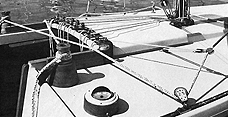|
Cal
20 Rigging Guide
The Bridge:
Everything
is placed on the bridge in a workable, logical manner. The three
swivel cam cleats in the middle of the bridge are the mainsail
control lines. The boom vang is the middle one of these three
cams. To the left is the Cunningham Downhaul. To the right is
the outhaul. These are the three lines that are most used on
the bridge, so they are all led through swivel cams. To the
right and the left of this group of swivel cams are the two
reefing lines, the clew reef to the left and the tack reef to
the right. To the left of the clew reefing line is the jib halyard
swivel cam cleat. This is also a heavily used line, so it leads
to a swivel cam. To the right of the tack reefing line is the
main halyard. In the two corners of the bridge are the Barber
haulers. Every system is bracketed on the bridge with yellow
tape and the cams are labeled, to help show the sectional divisions
on the bridge.
|

|
 |
Weather
Sheeting:
The
jib sheets can be led conventionally to the winch on the leeward
side of the boat, or they can be led across the cabin top to
the winch on the weather side of the boat. This is called weather
sheeting. Weather sheeting allows the crew to stay on the high
side where their weight is most effective and allows them to
keep the jib in perfect trim in the process. The sheet runners
and cheek blocks on the two sides of the sliding hatch and the
high pyramid teak winch pads allow the system to work efficiently,
whether the sliding hatch is open or closed. Note convenient
placement of clamcleats. |
|
|

